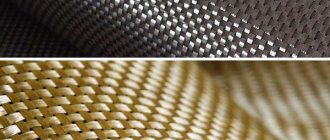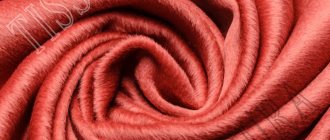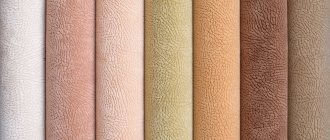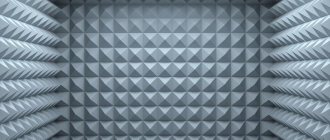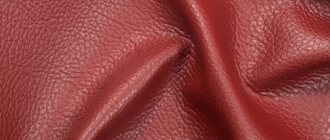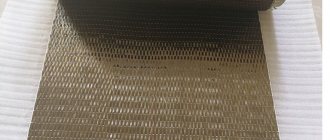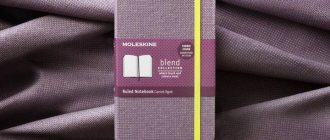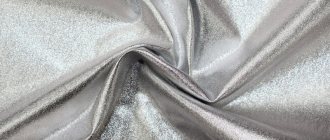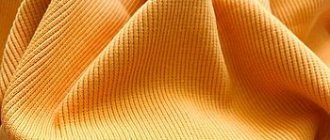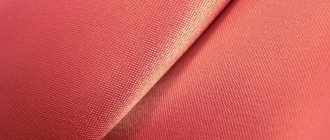Why are Italian fabrics good?
Italy has long gained fame as the flagship of the world fashion capital. Of course, the French competitors in the high fashion industry are also not in the last role, and they have a huge influence on the fashion industry... However, Italian craftsmen (both collection designers and fabric manufacturers) have always been able to find their own unique path. Italian style cannot be confused; Italian fabrics are equally easily recognizable in Moscow and in any other city on the planet.
Could it be otherwise if it was this land that gave humanity such creators as Leonardo, Raphael, Botticelli, whose works the country became known as the homeland of people with ideal taste, with an innate sense of style. It seems that knowledge of the laws of beauty is inherited by Italians with genes.
Probably every fashionista’s heart skips a beat when we once again hear the words Max Mara, Valentino, Versace...
Italian Masters are distinguished by impressive courage, they inspire admiration for their desire for innovation and at the same time reverent love for existing traditions. Every year on the catwalks we see not only unsurpassed collections, but also new Italian fabrics, which immediately become the basis on which tens of thousands of ateliers operate around the world; Italian fabrics are bought in small wholesale by millions of private tailors.
In fact, Italian fabric manufacturers rely on more than just stunning aesthetics. Everyone here knows a lot about quality, modern technology, and reliability. Excellent raw materials are always available here; the arsenal of the enterprises includes technologically advanced machines and knowledgeable, experienced people who value accuracy and precision.
They say that all roads lead to Rome, but in our case, all roads simply lead to Italy. Fabric production in this country is slightly localized. More accurately, we can note the conditional division of the territory into 3 conglomerates:
- Emilia Romagna focuses more on knitwear.
- Florence is famous for its traditions of working with wool (although, of course, there is everything here).
- The north of the country specializes in silk fabrics and other “dressy” materials for high fashion.
Everywhere in Italy, fabrics are offered to the client either as a regular product or in stock quantities. Regular materials are produced exclusively to your order. If you want to buy just such Italian fabric wholesale, then there will be no problems with either quantity or colors. But you will have to pay more and, most likely, the buyer will face the problem of a minimum order quantity limit.
Stock lots are usually those fabrics that were previously ordered by some famous brands. The advantages of textile stock include unsurpassed quality and “proven” popular design. The demand for Italian fabric from such residual batches is also at a relatively low price, but you need to understand that the quantity of stock goods is limited, and you should not forget that you will have to choose a product from models already existing in warehouses.
Experience shows that it is quite difficult to choose and order fabrics in bulk directly from Italy. But for this you don’t need to go to Europe or cooperate with intermediaries and brokers, just contact us by phone and, after consultation, make a purchase online, or we recommend coming to the warehouse of the IMBAL store in Moscow, which is located near the Kurskaya metro station.
It is clear that there are a lot of fabrics (different and necessary), therefore, despite all the abundance of goods, fabric stores are still popular, and with the advent of the worldwide information network, buying or ordering the necessary fabric has become even easier and faster. However, there remains one question that the buyer himself has to decide every time: What to choose? Which fabric will look better in a business suit or a summer sundress? What to buy for trousers, a coat, a cardigan – this material or this one? You always have to choose, and to do it correctly, you need to know the properties of fabrics, their features and main purpose.
For example, you can sew a light summer coat from silk, but the main purpose of this fabric is to sew elegant clothes. Linen fabrics are excellent, natural, their natural basis justifies some disadvantages in use, but linen business suits will hang in the wardrobe more than actually be worn. This is the case with almost any fabric, so the purpose determines the choice, and the more diverse the store’s assortment, the easier it is to find the right fabric. In our store you can find almost everything - from exclusive hand-painted canvases to fabrics for sewing products for every day.
Jacket Lady Charm
Photo: market.yandex.ru
Lady Sharm Classic is a brand that produces and distributes women's clothing. This is one of the most famous Russian brands for the production of clothing for women of non-standard sizes. Lady Sharm collections are developed by our own designers, taking into account the wishes of clients, as well as the nuances of their luxurious forms.
Jacket Lady Charm
Advantages:
- Custom size
- Own developments
- High quality
- Easy to care for
- Versatility and style
- Zip pockets
- There is a drawstring stitched along the bottom
Characteristics and types of fabrics
There are many classifications, but it is better to start, as they say, “from the stove”, since the basis of everything is always raw materials - natural or artificial. It is not so easy to understand this, because almost all natural fabrics already have their synthetic analogs, which are difficult to distinguish only by appearance. We will not talk about specialists, since this does not present any difficulties for them, but in the eyes of an ignorant person, natural silk and acetate silk are no different from each other. In such a situation, it’s not a sin to turn to the store manager for help, which, by the way, is quite easy in our store - they will show you, tell you, explain the difference, and advise what is best suited for what.
Natural fabrics, in turn, can be of plant or animal origin:
- Plant fabrics are cotton and linen, although the books also mention hemp fabrics and cellulose fabric fibers. If cotton fabrics are obtained from the soft fibers of the cotton plant (seed), then flax threads are the fruit of the flax stem, which is subjected to a series of procedures before the fiber itself is directly obtained. Both types of fabric have the same disadvantages: a high level of creasing and susceptibility to rapid color fading under the influence of ultraviolet radiation (sun rays).
- Animal natural fabrics are silk and wool of different types, and if silk is the threads of silkworm caterpillars, and therefore its properties are approximately the same in different types of fabrics, then with wool everything is more complicated. First, wool fibers can be taken from a variety of animals (from camels to rabbits); secondly, the wool itself can be from the same animal, but in different degrees of growth (down, undercoat, awn, or even dead hair). Wool fibers can be uniform, and then the fabric will be the same thickness, or heterogeneous, and then the woolen fabric can be thin, semi-fine or coarse.
Types and their properties
Based on the production method, fabrics for jackets are divided into several types. These are quilted jacket fabrics, they are obtained by connecting two or three layers of fabric together using a figured stitch. Warm jackets that do not need lining are made from three-layer materials.
Double-sided jacket fabrics do not have a reverse side. They open up a lot of scope for imagination when sewing outerwear. The quilted variety can be used to make a reversible jacket or coat.
Among raincoat and jacket fabrics, the following varieties are in great demand:
- Eco -leather is a durable synthetic material that looks like natural leather. It is elastic and does not deform when worn. After special treatment it does not get wet and repels dirt. Clothing made from it protects from the wind and is easy to care for. Demi-season jackets, raincoats, and jackets are made from eco-leather;
- taslan – jacket fabric made of polyamide. It is produced using a rep weave, so a thin scar is formed on the surface. One of the types of coatings PU, milky and WR is applied to the surface of the material. Demi-season and winter jackets are made from it;
- Duspo is a polyester material. It is durable, lightweight, protects from wind, while allowing the body to breathe. Protective impregnations make it water-repellent. The material is used to make demi-season outerwear;
- bologna - it is woven from nylon. The fabric is waterproof with a slight sheen and is resistant to stains. Windbreakers, raincoats, and demi-season jackets are often made from it;
- membrane jacket fabric - consists of three layers. Thanks to a special finely porous membrane, the material does not allow water to pass through, but perfectly removes body evaporation. It is completely windproof and has high thermal protection. Membrane fabrics are used to make travel equipment and outdoor sports suits for autumn and winter;
- Fitsystem jacket fabric is an innovative invention of South Korean manufacturers. The material, thanks to special impregnations, becomes water- and windproof. It retains heat well. Demi-season and winter jackets are made from it;
- Oxford is a mixed material, it is made from cotton combined with polyester or nylon. The material is water-repellent, durable and dense. It is used to make demi-season and winter outerwear;
- lacquer – mirror fabric for a jacket. Polyester fabrics are used for outerwear. The material is durable, has an attractive appearance, and repels water and dirt. Windbreakers and demi-season jackets are made from it.
Jacket fabrics are painted in various colors. The material is produced with print or embroidery.
Natural fabrics from Italy
They are created from natural sources, and therefore are the most hygienic, environmentally friendly, etc. First: all fabrics made from natural raw materials are perfectly “breathable”, so the skin does not experience any “inconvenience”. The second sign of naturalness is hypoallergenicity, which is also excellent, since the number of allergy sufferers is becoming more and more alarming every year.
Considering fabrics of this type in the price category, they can be arranged in a conventional chain: silk - wool - linen - cotton, i.e. Cotton fabrics are considered the most inexpensive. Purchasing cotton fabrics in our store in bulk is profitable; moreover, Italian-made cotton fabrics are of excellent quality and are in no way inferior to silk in color. The more different fibers are mixed into one fabric, the more diverse the resulting material will be, the more useful properties, and the higher the quality.
- Cotton fabrics. Remaining at the base of the fabric, cotton fiber with the addition of threads that have properties that cotton lacks produces excellent blended fabrics. Due to its flexibility, cotton thread allows the use of different types of weave, and the weaving of synthetic fibers makes it possible to obtain a fabric that practically does not wrinkle, easily restores its shape when ironed, and retains its color for a long time. In production, fine-fiber cotton is transformed into an elegant voile or the finest cambric, delicate volte or durable poplin.
- Woolen fabrics are the most comfortable and convenient fabrics for sewing warm clothes of any kind: jackets, windbreakers, coats, shawls, suits, etc. You can easily make even lovely blouses or summer outfits from the finest wool, but coarse, dense wool is perfect for a winter coat or jacket. By the way, outerwear made of purely natural wool fabric is a kind of symbol of high status, since wearing an expensive coat made of dressed wool in the subway or trolleybus would be nonsense. Too high quality looks alien among the many similar jackets made of raincoat fabric, and such woolen fabric requires a lot of care, and therefore it is better not to get it dirty. Italian woolen fabrics are always of the highest quality, so business or hunting suits, coats or jackets, scarves or accessories are purchased for a long time. Thin but warm jumpers, skirts, stoles, blazers and other things that can be sewn from wool fabric will last a long time with proper care.
- Linen fabrics are the most durable material from the category of natural linens, although it has all the characteristics of other types. In addition, even after prolonged treatment, linen retains bactericidal properties and can adsorb skin secretions while maintaining a “breathable” effect. You can sew everything from linen fabrics - from simple sundresses to stylish summer coats and hat covers. Unfortunately, with all its advantages, linen fabrics wrinkle very much, sometimes creases occur that cannot be removed by ironing with steam, and therefore synthetic fibers began to be added to most linen fabrics. Just 2% lycra, and linen becomes more manageable, while the products retain all the properties of linen fabric, but do not wrinkle, they can be used daily without the threat of spoiling.
- Silk fabrics of natural fibers are a capricious material, but only in sewing, since the fabric does not require any special refinements in wearing or caring for. When artificial fibers are added, silk becomes elastic, fits tightly to the figure, but continues to retain all its qualities. Very beautiful fabrics are obtained by mixing natural silkworm fiber and the acetate component. Model shows clearly demonstrate how flowing chiffon or satin, dupont or taffeta, satin or toile becomes when synthetic fiber is added to the weave.
What kind of fabric
Jacket fabrics are classified as a separate large group of materials. As the name suggests, outerwear is made from them. The general requirement for all types of fabrics is water resistance, high heat protection and protection from wind.
Their properties, such as strength and color fastness, allow us to better understand what kind of materials they are. They can be completely different in texture. And with a pronounced shine or matte, with a relief surface or absolutely smooth.
Disco fabric. Photo
You can often find the name of the fabric jacket and raincoat fabrics. Is it only the type of clothing produced from them that distinguishes these materials? If we turn to the requirements of GOST 29222-91 and GOST 28486-90, it turns out that raincoat fabrics have higher water resistance. Therefore, combining materials into one group is not entirely correct.
Artificial fabrics from Italy
As a rule, purely artificial fabrics are rarely used for sewing clothes that are worn without underwear. Such fabrics do not have the most important quality for this: the fabrics do not “breathe”, which means the skin does not receive air flow. A person wearing such clothes will experience overheating or, on the contrary, hypothermia, because things made of artificial fiber will only maintain the temperature of the person’s body, preventing heat from the outside.
There are several types of artificial fibers used to create fashionable fabrics:
- polyamide (nylon, nylon fabrics, taslan, perlon, etc.). They do not absorb moisture at all, so they can be used for sewing uniforms and outerwear;
- polyester (microfiber, lavsan, polyester, tergal, etc.). Compared to polyamide fabrics, they are softer and lighter, but are just as resistant to wear;
- polyvinyl chloride fabrics are used for sewing tourist or other equipment, but the fabrics are not suitable for clothing;
- polyurethane fabrics (lycra, supplex, elastane, etc.) are also used only for special-purpose clothing and special equipment;
- polypropylene fabrics are used for sewing thermal underwear, since they have the maximum effect of retaining body heat;
- acrylic fabrics are pleasant to the touch, the fibers combine well with natural threads.
Sometimes different types of mixed fabrics from Italy are classified into a separate category. The introduction of artificial fibers into the composition significantly improves the properties of natural fabrics, making them more elastic, stretchy, flexible and very durable, generally more durable and more convenient to use.
In order for the fabrics to receive a special aesthetic filling, in addition to the use of unique prints, they are “flavored” with various auxiliary elements/techniques, such as: Lace, Lurex, Fur, Embroidery, Braid, Sequins, Fringe, Perforation, Creche...
To order, we recommend calling us, as sometimes some items have already arrived at the warehouse, but simply do not have time to get on the pages of the website catalog. Moreover, when communicating with experienced consultants by voice, you will be able to find out all the necessary information, from the specific characteristics of a particular fabric, to the selection of material for solving certain problems and the choice of “companion fabrics”.
Duspo fabric: what it is, description and characteristics
This is a relatively young fabric that has appeared on the Russian market. The fabric composition is 100% polyester, standard plain weave. Synthetic jacket materials can be superior in quality to natural ones. Dewspo's main suppliers are China and Korea. Difficulties with raw materials and high taxes on chemical enterprises make production in Russia unprofitable. Dyuspo has a number of distinctive characteristics:
- finer fiber structure;
- wide range of colors;
- very light and soft texture;
- windproof impregnation;
- water-repellent properties;
- good vapor permeability;
- presence of companion tissues.
Surprisingly, Duspo is a purely synthetic material. First, a fabric 150 cm wide is made from polyamide threads. Plain-dyed fabric is formed directly from dyed threads. Dyspeau with drawings is made of white polymer fabric, then any prints are transferred to it. Density can vary from 85 to 240 g/m2. Next, depending on the purpose, Dewspo is treated with various impregnations and sprayings.
Types of impregnations and treatments
The fabric itself does not have the necessary consumer qualities. Modern industry produces impregnating compounds that are harmless to people and the environment. Thanks to special processing, the materials are resistant to moisture and dirt, and provide warmth and dryness during outdoor activities.
Deciphering the icons on the labels of warm jackets and other things will give you an understanding of what kind of impregnation is used and what it is used for.
- PU is an invisible impregnation, the transparency of which allows it to be applied on both sides of the fabric. The main task is to give Dyuspo water-repellent characteristics, resistance to abrasion and dirt.
- WR – transparent polymer coating on the outside, will also provide moisture resistance. The main advantages of a polymer coating is that this impregnation helps water droplets roll off clothes without getting inside. Products made from this material, combining functionality and protection, can be worn in rainy weather and heavy snowfall.
- Impregnation Milky (Visible) “Milky” is a visible coating of milky color on the reverse side, hence the name “Milky” (milk). With this effect, the material is given a down-holding property, which is indispensable when sewing down jackets for children and adults. Another important characteristic that the “milka” treatment has is color protection. The color does not fade either in the sun or during washing.
- Peach Skin - velvety top coating on the front side. It got its name because of the “velvet skin” effect, which gives Dewspo a nobility. High-end jackets, raincoats, and tracksuits are made from it.
- Ray (Ray) is a lightweight cushion (85 g/m2), from which a range of children's winter clothing is made. Impregnation imparts rigidity to the fabric structure and a pearlescent surface.
- Cire (Cire) - impregnation on top makes the canvas shiny, glossy. Cire is more often used for sewing children's clothing, less often for women's clothing.
- Bonding is not impregnation, but a combination of two types of fabrics. Knitted or fleece fabric is applied to the underside of the bonding blanket, and the layers are held together under pressure. This gluing (bonding) allows Dewspo to have warm properties comparable to wool. Under the upper fabric there is PU impregnation to protect against moisture. The density of knitwear and fleece is determined by consumer demand from clothing manufacturers. The two-layer cushion is becoming more and more popular every day. It is used to produce tracksuits and various functional clothing from well-known brands.
- Jaqard (Jacquard) - the textured pattern of the surface of the fabric is visible and palpable with your hands. Jacquard is used as a finishing or main material for the manufacture of down jackets, jackets, hats, bags, strollers and baby carriers.
- Punching is a perforated fabric (with frequent small holes) used for finishing or in areas of heavy sweating. On the surface, punching looks like a cool design solution, but in fact it helps the skin breathe.
- PRT is a sign indicating fabric with a print (pattern). Printed materials are often produced as companion fabrics. This means that in the released line of materials for this print you can choose a plain material of the same texture and finish.
Names of fabrics with descriptions
Manufacturers offer different fabrics for jackets. The material differs in characteristics and is used for sewing products with different purposes.
Duspo
The material for the jacket is made of polyamide. It can be velvety, glossy or shiny. Available in different colors.
A jacket made from “dyuspo” allows air to pass through well, but at the same time provides excellent protection from wind and rain. The fabric is durable, easily takes the shape specified when sewing, and does not wrinkle.
Dyuspo is often chosen as a material for ski jackets and mountaineering suits, as the textile protects well from the cold and is resistant to ultraviolet radiation. This is also a good fabric for a down jacket.
Greta
This is a mixed textile, represented by a mix of cotton and polyester. Thanks to the twill type of weave of threads, the wrong side is natural, and the outer side is synthetic.
Fact! Greta is chosen for sewing children's outerwear, as well as special uniforms, for example, for food industry workers.
The fabric responds well to additional treatment with waterproof or oil-repellent impregnation. Textiles are easy to dye even to match camouflage.
Taffeta
Belongs to the group of synthetic fabrics. Made from polyester or nylon fibers. Depending on the composition, it has distinctive characteristics.
Author:
Anastasia Kukushkina
I hope you enjoy the article I have prepared for you! If you find errors in it, write to me about it! I will answer any questions you have, ask them!
